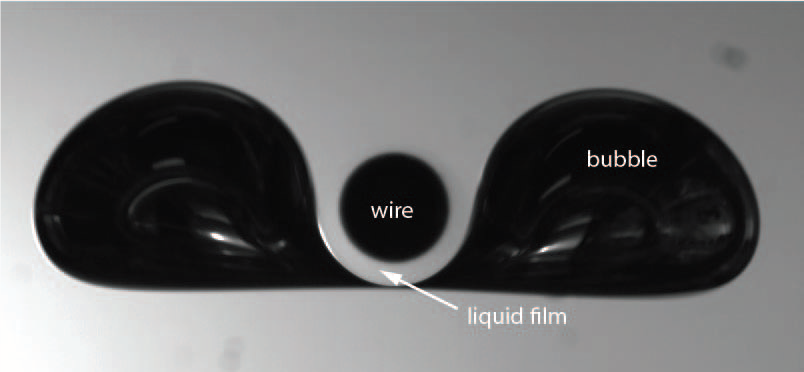Cutting rising bubbles without contact
Background:
Bubble columns are widely used multiphase reactors for industrial applications. Conversion of bubble columns mainly relies on heat and mass transfer between the phases, which are dependent on the effective transfer area and residence time. Often structured packings or wire-meshes are used as reactor internals to reduce bubble size by cutting the bubbles. This enhances efficiency by both increasing the interfacial area and reducing the bubble rise velocity, extending contact time. The wire mesh may further serve as support for a catalytic coating [1], which may modify the wettability. Previous studies investigated the interaction of a single bubble with a solid wire for a wide range of parameters like bubble size and velocity [2, 3] but did not address the influence of wire wettability. Recent numerical simulations indicate that the latter may affect the bubble-wire interaction especially under hydrophobic conditions [4]. However, these simulations have not been validated by experiments so far and the exact physical mechanisms governing the bubble-wire interaction are still largely unknown.
Project:
In this work, the effect of wettability on the bubble cutting process is investigated by bubble cutting experiments using cylindrical wires made of different material (glass with and without hydrophobic coating, stainless steel, teflon). An air bubble is generated at the bottom of a container filled with a high viscosity liquid (90 w% glycerol-water mixture). Besides the wire wettability (contact angle 40 – 150°) and wire diameter (3 – 5 mm), the bubble size (50 – 1000 µl) and thus the bubble rise velocity is varied. The rising bubble and its interaction with the horizontal wire/cylinder is captured by high- speed imaging using backlight illumination. Subsequent image processing delivers the sizes of mother and daughter bubbles and potential satellite bubbles are tracked in time. Additional information such as the thickness of the liquid film and the length of the gas thread connecting the two daughter bubbles is obtained.

Results show that for all experiments in the studied viscosity regime there is no actual contact between bubble and wire. A uniform liquid film forms during bubble-wire interaction as shown in Figure 1. In contrast to numerical predictions [4], wettability does not influence the bubble cutting process in the measured parameter range. The thickness of the evolving liquid film increases with bubble volume and is largely independent from wire diameter and material. Only the behavior of a central satellite bubble which may form during the cutting of very large bubbles via the breakup of the thinning gas thread is observed to depend on the wire wettability.
Contact: Dr. Marion Börnhorst
References:
[1] Höller, V., Radevik, K., Kiwi-Minsker, L., Renken, A. Bubble Columns Staged with
Structured Fibrous Catalytic Layers: Residence Time Distribution and Mass Transfer. Ind.
Eng. Chem. Res., Vol. 40, pp. 1575 – 11579 (2001)
[2] Baltussen, M.W., Segers, Q.I.E., Kuipers, J.A.M., Deen, N.G. Cutting bubbles with a
single wire. Chem. Eng. Sci., Vol. 157, pp. 138 – 146 (2017)
[3] Segers, Q.I.E., Cutting Bubbles using Wire-Mesh Structures - Direct Numerical
Simulations, PhD thesis, Eindhoven University of Technology, 2015
[4] Cai, X., Wörner, M., Marschall, H., Deutschmann, O. Numerical study on the wettability
dependent interaction of a rising bubble with a periodic open cellular structure. Catalysis
Today, Vol. 273, pp. 151 – 160 (2016)
